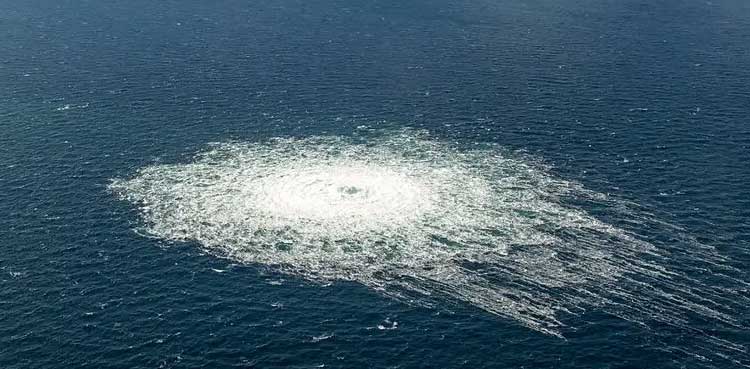Sweden announced on Wednesday that it had dropped its investigation into the explosions in 2022 on Nord Stream pipelines carrying Russian gas to Germany and had handed evidence it had uncovered over to German investigators.
Here is what we know so far about the blasts, which destroyed three out of four pipelines, hastening Europe’s switch to other energy suppliers following Russia’s invasion of Ukraine. No one has taken responsibility:
WHAT IS NORD STREAM?
Nord Stream 1 (NS1) and Nord Stream 2 (NS2), each consisting of two pipes, were built by Russia’s state-controlled Gazprom to pump 110 billion cubic metres (bcm) of natural gas a year across the Baltic Sea to Germany.
The four concrete-coated steel pipelines of about 1,200 km (750 miles) in length and more than 1 m in diameter lay at a depth of around 80-110 m. One string of NS2 pipeline remains intact.
NS1 came on stream in 2012. NS2 was completed in September 2021 and filled with gas, but has never been commissioned.
Germany cancelled its approval process days before Russia’s invasion of Ukraine on Feb. 24, 2022, which put Europe’s reliance on Russian natural gas in the political spotlight.
WHO OWNS THE PIPELINES?
Russia’s Gazprom owns 51% of NS1 and 100% of NS2.
Germany’s E.ON and Wintershall Dea have 15.5% of NS1, while French Engie and Dutch Gasunie have 9% each.
The Western owners have written off all their investments since the explosions.
While NS2 is fully owned by Gazprom, Western companies – British Shell, Germany’s Wintershall Dea and Uniper, French Engie and Austria’s OMV – covered 50% of the pipelines’ total construction costs of about $11 billion.
All five Western companies have written off their full financing of NS2, amounting to about 1 billion euros each.
There have been no plans announced to repair the damage.
HOW WERE THE PIPELINES DAMAGED?
On Sept. 26, 2022, Swedish seismologists registered several blasts, some 17 hours apart, off the Danish island of Bornholm that ruptured three out of four lines of the Nord Stream system, sending plumes of methane into the atmosphere.
Gazprom said about 800 million cubic metres of gas, equivalent to about three months of Danish gas supplies, had escaped. It took several days for the gas to stop leaking.
Sweden has found traces of explosives on several objects recovered from the explosion site, confirming it was a deliberate act.
In July, Germany told the U.N. Security Council that it also found traces of subsea explosives on a sailing yacht that “may have been used to transport the explosives”.
Germany has confirmed its investigators raided a ship, identified by German media as the 50-foot (15-metre) sailing yacht, in January last year that may have been used to transport the explosives used to blow up the pipelines.
The boat, leased in Germany via a Poland-registered company, contained traces of octagon, the same explosive that was found at the underwater blast sites, according to investigations by Germany, Denmark and Sweden.
Germany told the U.N. that it was possible for trained divers to attach explosives to the pipelines laying at about 70 to 80 meters deep where explosions occurred.
WHO IS BEHIND THE EXPLOSIONS?
Some U.S. and European officials initially suggested Moscow had blown up its own pipelines, an interpretation dismissed as “idiotic” by Russian President Vladimir Putin.
Instead, Putin has blamed “Anglo-Saxons”, using Kremlin’s term for the U.S. and Britain, without providing evidence. It has also blamed Ukraine. All three countries deny any role.
The White House last year dismissed a blog post by a U.S. investigative journalist alleging Washington was behind explosions as “utterly false and complete fiction.”
The U.S. and German media have reported that the yacht could have been used by a Ukrainian or pro-Ukrainian group, citing leaked intelligence reports and people familiar with official investigations. Kyiv has repeatedly denied any involvement.
HOW MIGHT AN ATTACK HAVE BEEN CARRIED OUT?
In November last year, The Washington Post reported that Roman Chervinsky, a former intelligence official who served in the Ukrainian military’s special forces, managed the six-person team, but did not plan the attack. He denied involvement.
The Post said Chervinsky took orders from senior Ukrainian officials who ultimately reported to Commander-in-Chief General Valery Zaluzhnyi. Reuters was unable to verify the report independently. Zaluzhnyi has made no public comment.
Germany’s Der Spiegel and ZDF have said that a group of six people – five men and one woman – boarded Andromeda in Rostock, Germany, on Sept. 6, using forged passports, and returned to Rostock on Sept. 23.
The yacht was spotted at a small Danish island of Christianso, near the explosion sites, on Sept. 16-18, and made a short stop at a marina in Kolobrzeg, Poland on Sept. 19, before returning to Germany.
Poland said in January it has been cooperating with allies in a probe into the sabotage of the Nord Stream pipelines.
There was no evidence to suggest that Poland was used as a hub for the sabotage, Polish prosecutors said last year.
WHAT DID WESTERN INTELLIGENCE KNOW ABOUT THE ATTACK?
A day after the explosions, on Sept. 27, 2022, German magazine Der Siegel wrote that the CIA had warned Germany in summer 2022 about possible attacks on Baltic Sea pipelines.
The Washington Post, citing leaked information posted online, wrote last June that the United States learned of a Ukrainian plan to attack the Nord Stream natural gas pipelines three months before they were damaged.
The intelligence report was based on information provided by a source in Ukraine, the Post said, adding the CIA shared it with Germany and other European countries in June 2022.
Dutch national broadcaster NOS reported the same month that the tip came from the Dutch military intelligence agency MIVD.
According to the Post, the CIA relayed to Zaluzhnyi through an intermediary that the United States opposed such an operation.
Reuters was unable to verify the reports independently.









